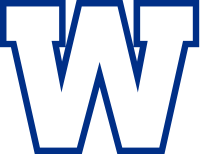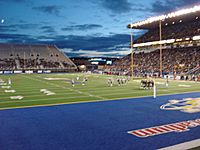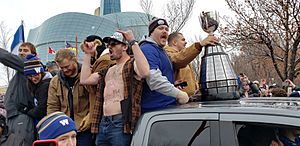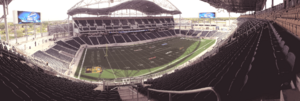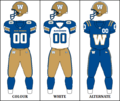Winnipeg Blue Bombers facts for kids
| Founded | 1930 |
|---|---|
| Based in | Winnipeg, Manitoba, Canada |
| Home field | Osborne Stadium (1935–1952) Canad Inns Stadium (1953–2012) Princess Auto Stadium (2013–present) |
| Head coach | Mike O'Shea |
| General manager | Kyle Walters |
| Team president | Wade Miller |
| Owner(s) | Winnipeg Football Club (a non-profit corporation) |
| League | Canadian Football League |
| Division | West |
| Colours | Royal blue, metallic gold, white |
| Nickname(s) | Bombers, Blue and Gold, Big Blue, True Blue |
| Mascot(s) | Buzz and Boomer |
| Grey Cup wins | 12 (1935, 1939, 1941, 1958, 1959, 1961, 1962, 1984, 1988, 1990, 2019, 2021) |
| Current uniform | |
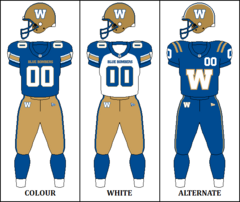 |
|
The Winnipeg Blue Bombers are a professional Canadian football team. They are based in Winnipeg, Manitoba, Canada. The Blue Bombers play in the Canadian Football League (CFL). They are part of the league's West division. Their home games are played at Princess Auto Stadium.
The team started in 1930. Back then, they were called the Winnipeg Rugby Football Club. Later, their name changed to the Winnipeg Football Club, which is still their official legal name. The Blue Bombers are one of two teams in the CFL that are owned by the community. This means they do not have shareholders.
Since they began, the Blue Bombers have won the Grey Cup championship 12 times. Their most recent win was in 2021. They beat the Hamilton Tiger-Cats 33–25 in the 108th Grey Cup. The team has played in the Grey Cup more than any other team, with 29 appearances. Winnipeg was also the first team from Western Canada to win a championship.
Contents
Team Facts
- Founded: 1930
- Helmet design: Gold background with a white "W" and blue trim.
- Uniform colours: Blue, gold, and white.
- Nicknames: Bombers, Blue and Gold, Big Blue.
- Mascots: Buzz and Boomer.
- Fight Song: "Bombers Victory March."
- Stadium: Princess Auto Stadium (since 2013).
- Main rivals: Saskatchewan Roughriders and Hamilton Tiger-Cats.
- Grey Cup Championships: 12 times.
- 2024 regular season record: 11 wins, 7 losses.
Community Ownership
The Winnipeg Blue Bombers are run by the Winnipeg Football Club (WFC). This club is a non-profit organization. It was created in Manitoba on March 5, 1951. The main goal of this group is to help football grow in Manitoba.
The WFC also manages Triple B Stadium Inc. This is another non-profit group. Its purpose is to build and run a stadium at the University of Manitoba. This stadium is Princess Auto Stadium. The stadium is used by the Blue Bombers, the University of Manitoba Bisons (another sports team), and for other public events.
The WFC also runs Valour FC Inc. This group operates a professional soccer team in Winnipeg. This team plays in the Canadian Premier League (CPL).
Team History
How the Team Started
The first football team in Winnipeg was formed in 1879. It was called the Winnipeg Rugby Football Club. On June 10, 1930, another team, the Winnipeg Tammany Tigers, joined with other city teams. They formed a new Winnipeg Rugby Football Club. People often called them the Winnipegs. They wore green and white uniforms. Their first game was on June 13, 1930, and they lost 7–3.
In 1932, the Winnipegs and another team, St. John's, joined together. They changed their team colors to blue and gold. In 1933, they also added players from the Garrison Rugby Club. The Winnipegs played in the Manitoba Rugby Football Union until 1935. Before moving to Osborne Stadium in 1935, they played at other parks.
First Grey Cup Win
Before 1935, teams from Western Canada had played in the Grey Cup 10 times. But they had never won. The teams from the East were much stronger. On December 7, 1935, the Winnipegs finally made it to the 23rd Grey Cup. The game was in Hamilton, Ontario. Their opponents were the home team, the Tigers. It was a rainy day, but 6,405 fans came to watch.
Winnipeg quickly scored, taking a 5–0 lead. A Hamilton player fumbled the opening kickoff. Winnipeg recovered the ball close to the Hamilton goal line. Winnipeg scored a touchdown with a pass from Bob Fritz to Bud Marquardt. They scored another touchdown, and at halftime, Winnipeg was up 12–4. Hamilton scored in the second half, making the score 12–9.
Then, Fritz Hanson of Winnipeg caught a punt. He ran 78 yards for a touchdown, making the score 18–10. Hamilton tried to catch up but could not score another touchdown. The final score was Winnipeg 18, Hamilton 12.
With this win, Winnipeg became the first team from Western Canada to win the Grey Cup.
Early Days of Success
After the 1935 Grey Cup win, a sports writer called the team the "Blue Bombers of Western football." The team quickly started using "Winnipeg Blue Bombers" as their nickname. The name was inspired by boxer Joe Louis, who was known as the "Brown Bomber."
In 1935, the Blue Bombers, Calgary Bronks, and Regina Roughriders formed a new league. It was the top league in Western Canada. Between 1936 and 1949, the Bombers played for the Grey Cup many times. They won twice: in 1939 and again in 1941.
Jack Jacobs, also known as Indian Jack, was a talented quarterback. He joined the Bombers in 1950. He led the team to two Grey Cup games. His exciting way of playing made the team very popular. More people came to watch games. This extra money helped the team move to a new, bigger stadium. Fans even called the new stadium "The House that Jack Built." Jacobs retired in 1954.
In 1951, Jack Jacobs was the first professional football quarterback to throw for over 3,000 yards in a season. He threw for 3,248 yards. That year, he also threw for 33 touchdowns, which was a record. The next year, he threw for 34 touchdowns.
The Bud Grant Era
Bud Grant joined the team in 1953. He had played for the Philadelphia Eagles before. Many NFL players came to Canada then for better pay. After playing as a receiver for four years, Grant became the head coach of the Bombers in 1957. He coached the team for 10 years. Later, he became a head coach in the NFL.
In 1958, the Blue Bombers joined the new Canadian Football League. They have played there ever since.
During Grant's time as coach, many great players joined the team. These included Ken Ploen, Leo Lewis, and Ernie Pitts. The Bombers played in six Grey Cup games with Grant as coach. They won four of them (1958, 1959, 1961, and 1962). In 1961, the Bombers won 21–14 in the first Grey Cup game to go into overtime. The Bombers and Hamilton played again in the 1962 Grey Cup. This game was famous for being stopped because of heavy fog. It was called the "Fog Bowl." The game finished the next morning, with the Bombers winning 28–27.
The team struggled in the late 1960s. But they improved in the early 1970s. They finished first in their conference in 1972. This was their first time since 1962. However, they lost in the Western final. The team continued to face challenges for a few more seasons.
The Cal Murphy Era
In 1983, Cal Murphy became the new head coach. He made a big trade, getting quarterback Tom Clements. Clements led the Bombers to a huge win in the 1984 Grey Cup. This was Winnipeg's first Grey Cup win in 22 years. Murphy was named coach of the year in 1983 and 1984.
In 1987, Murphy became the general manager. Mike Riley took over as head coach. The league moved the Blue Bombers to the East Division to balance the teams.
Under Riley, the Blue Bombers quickly became strong in the East. They won Grey Cups in 1988 and 1990. Riley also won coach of the year awards. Cal Murphy returned as head coach in 1993. He led the team to five Grey Cup appearances in total. He won as a coach in 1984 and as GM in 1988 and 1990. He left the team after the 1996 season.
Winnipeg played in the East Division for eight seasons. Then, they moved to a new North Division in 1995. When the American teams left the CFL, the Blue Bombers returned to the West Division. They moved back to the East Division in 1997.
The Milt Stegall Era
In November 1996, Cal Murphy left the Blue Bombers. The team had not been winning much. Jeff Reinebold became the new coach. Despite big promises, the team did not do well in 1997 and 1998.
A few good things happened during this time. Milt Stegall became an all-star in 1997. He scored many long touchdowns. The team also had a big win over the Saskatchewan Roughriders in 1997.
Milt Stegall joined the Bombers in 1995. In 1997, he set a league record for average yards per catch. He gained 26.5 yards on 61 catches for 1616 yards, including 14 touchdowns. Stegall became the team's main receiver.
In 1999, the Bombers got Khari Jones. Stegall and Jones helped the Bombers become a top team again. Jones was the CFL's most outstanding player in 2001. Stegall won the award in 2002. Charles Roberts also joined the team in 2001. That year, the Bombers went to the Grey Cup but lost. The team was very strong from 2001 to 2003.
In 2004, Jones was traded. Kevin Glenn became the starting quarterback. In 2006, Winnipeg returned to the East Division.
Glenn, Stegall, and Roberts led the Bombers back to success in 2006. A famous moment was "The Play" on July 20, 2006. With seconds left, Milt Stegall caught a 100-yard touchdown pass from Kevin Glenn. This won the game 25–22. Many people call it the greatest play in CFL history.
The 2007 season was a big year for Milt Stegall. He broke the CFL record for career touchdowns. The 2007 Grey Cup was between the Blue Bombers and the Saskatchewan Roughriders. It was the first time these two teams met for the championship. Winnipeg lost 23–19. Their starting quarterback, Kevin Glenn, broke his arm before the game. A rookie quarterback had to play.
Milt Stegall returned for the 2008 season. He was close to breaking the all-time receiving yards record. Other players also took less money to stay with the team, hoping to win the Grey Cup. The Bombers made some trades in 2008. After the 2008 season, coach Doug Berry was fired. Mike Kelly took over. Milt Stegall retired from the CFL on February 18, 2009. This marked the end of an era.
Recent Years and Grey Cup Wins
Paul LaPolice became the head coach in 2010. He focused on teamwork. In 2010, the team finished with only 4 wins and 14 losses. But in 2011, they turned things around. They finished first in the East Division with a 10–8 record. Their strong defense, called "Swaggerville," helped them. They reached the 99th Grey Cup but lost.
In 2013, there were changes in the team's leadership. Wade Miller became the CEO and president. Kyle Walters became the general manager.
Mike O'Shea was hired as head coach on December 4, 2013. He helped the team return to the playoffs. In the 2019 season, injuries to key players made things tough. But the Bombers traded for Zach Collaros. He and Chris Streveler played quarterback. Their strong defense helped the team win their 11th championship at the 107th Grey Cup. This ended a 28-year wait for a Grey Cup win. Andrew Harris, a local player, became the first to win both Grey Cup MVP and Most Valuable Canadian.
The CFL cancelled its 2020 season. But in 2021, the league returned. The Bombers finished first in the West Division. This was their first time since 1972. They beat the Saskatchewan Roughriders in the West Final. Then, they faced the Hamilton Tiger-Cats in a rematch of the 2019 Grey Cup. The Bombers won the 108th Grey Cup in overtime, 33–25. They became the first team to win back-to-back Grey Cups since 2009. In 2022, they finished first in the West again. They reached the Grey Cup Final for the third year in a row. However, they lost to the Toronto Argonauts 24–23. In 2023, they won the West Division again. But they were upset by the Montreal Alouettes in the Grey Cup.
Current Personnel
Football Operations Staff
Front Office
Equipment Staff
|
Head Coaches
Offensive Coaches
Defensive Coaches
Special Teams Coaches
Video Coaches
→ Coaching Staff |
|||||
Roster
Quarterbacks
Receivers
Running Backs
Fullbacks/Tight Ends
|
Offensive Linemen
Defensive Linemen
|
Linebackers
Defensive Backs
Special Teams
|
1-Game Injured
6-Game Injured
|
Practice Squad
Suspended
|
|||||||
| Italics indicate American player • Bold indicates Global player • 46 Roster, 12 Injured, 12 Practice, 1 Suspended, 15 Rookies* Roster updated 2022-11-12 • Depth chart • Transactions • More CFL rosters |
|||||||||||
Management
Head Coaches
The Winnipeg Blue Bombers have had many head coaches throughout their history. Some notable coaches include Bud Grant, who led the team to four Grey Cup wins, and Cal Murphy, who coached the team to a Grey Cup victory in 1984. The current head coach is Mike O'Shea, who has led the team to recent Grey Cup championships.
General Managers
The general manager is in charge of the team's players and overall football operations. Many people have served as general manager for the Blue Bombers. The current general manager is Kyle Walters.
Stadium
In their early years, the Blue Bombers played at Osborne Stadium. It was a small stadium. When quarterback Jack Jacobs became popular, more fans came to games. This meant they needed a bigger stadium. Winnipeg Stadium was built in 1953. The Blue Bombers played there for many years. Its name changed to Canad Inns Stadium in 2001.
Over time, there were plans to build a new stadium. In 2008, a plan was made to build a new stadium at the University of Manitoba. This stadium would be used by the Blue Bombers and the University of Manitoba Bisons.
On May 2, 2012, the Blue Bombers announced that the new stadium would not be ready until September. This meant they had to play some home games at Canad Inns Stadium. In June 2012, it was announced the stadium would not open until the 2013 season.
The Blue Bombers played their first home game at Princess Auto Stadium on June 27, 2013. They lost 38–33 to the Montreal Alouettes.
Players of Note
Canadian Football Hall of Famers
Many Blue Bombers players and builders have been honored in the Canadian Football Hall of Fame. These are people who have made a big impact on Canadian football. Some famous names include Bud Grant, Jack Jacobs, Leo Lewis, Ken Ploen, and Milt Stegall.
Winnipeg Blue Bombers Ring of Honour
The Blue Bombers have a "Ring of Honour" at their stadium. This special place celebrates important players and people from the team's history. Fans help choose who gets added to the Ring of Honour each year. The first person honored was Chris Walby in 2016. Other members include Ken Ploen, Gerry James, Milt Stegall, Dieter Brock, Leo Lewis, Bud Grant, Herb Gray, Doug Brown, Jack Jacobs, Fritz Hanson, Bob Cameron, Bob Irving, Joe Poplawski, James Murphy, and Charles Roberts.
Images for kids
See also
 In Spanish: Winnipeg Blue Bombers para niños
In Spanish: Winnipeg Blue Bombers para niños


